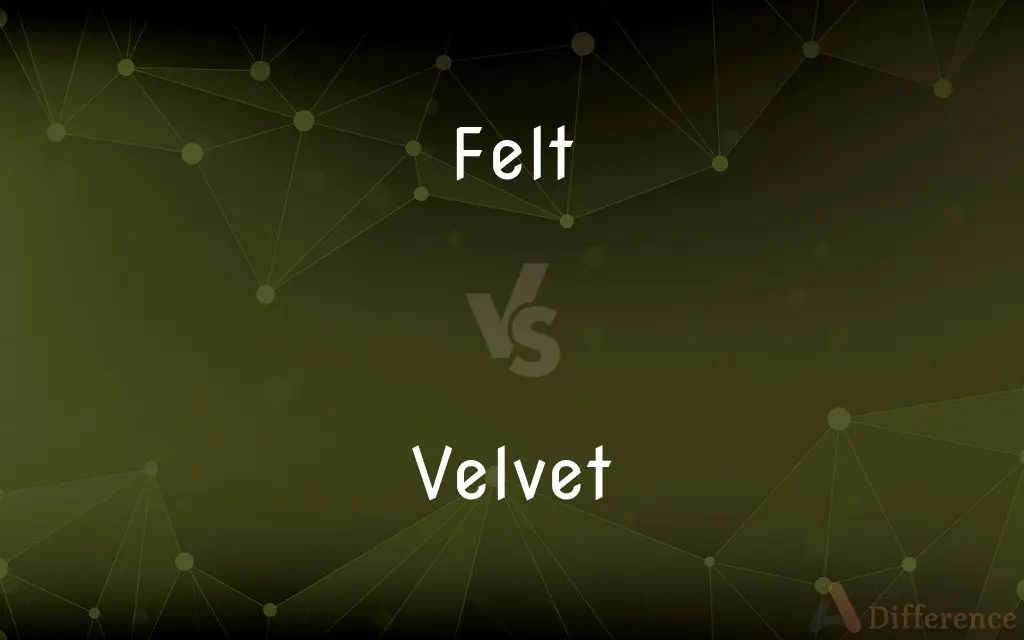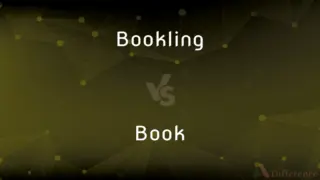Felt vs. Velvet — What's the Difference?
By Fiza Rafique & Urooj Arif — Updated on March 8, 2024
Felt is a non-woven fabric made through matting, while velvet is a woven, tufted fabric known for its soft feel.

Difference Between Felt and Velvet
Table of Contents
ADVERTISEMENT
Key Differences
Felt is created by compressing and matting fibers together, a process that does not involve spinning or weaving. This results in a durable fabric that is often used in crafts and industrial applications. On the other hand, velvet is produced by weaving two thicknesses of fabric simultaneously, which are then cut apart to create a short, dense pile on one side, giving it a distinctive soft feel. This method makes velvet a luxurious fabric commonly used in clothing, upholstery, and drapery.
Felt can be made from a variety of materials, including wool, rayon, and synthetic fibers, which contributes to its versatility in use. Whereas velvet, traditionally made from silk, can also be made from cotton, synthetics, and even blends, affecting its texture and appearance. The base material influences both the durability and the care required for the fabric.
Felt is characterized by its non-woven nature, making it inherently durable and resistant to fraying and unraveling. This characteristic makes it ideal for use in items that require a certain degree of structural integrity, such as hats, footwear, and felt boards. Velvet, with its woven structure and cut fibers, is more prone to crushing and requires careful handling and storage to maintain its luxurious texture.
The manufacturing process of felt involves matting, condensing, and pressing the fibers, which can be done through wet felting or needle felting. Velvet’s production, however, involves a more complex process of weaving with a special loom that weaves two pieces of velvet simultaneously. This difference in manufacturing reflects the distinct textures and applications of the two fabrics.
Felt is often appreciated for its insulating properties and ability to retain heat, making it a popular choice for winter garments and home insulation. Velvet, while also warm, is sought after more for its aesthetic appeal and the elegance it adds to garments and furnishings rather than its thermal properties.
ADVERTISEMENT
Comparison Chart
Fabric Type
Non-woven
Woven, tufted
Manufacturing Process
Matting, condensing, and pressing fibers
Weaving with a loom and cutting to create pile
Material Varieties
Wool, rayon, synthetics
Silk, cotton, synthetics, blends
Durability
High, resistant to fraying and unraveling
Prone to crushing, requires careful handling
Common Uses
Crafts, industrial applications, clothing
Clothing, upholstery, drapery
Compare with Definitions
Felt
Durable and versatile for various applications.
She chose felt for the project due to its durability and ease of use.
Velvet
Used in high-end and decorative applications.
The designer chose velvet for the lounge’s sofas for its luxurious feel.
Felt
Can be made from wool, synthetic, or blended fibers.
Wool felt is preferred for its natural texture and warmth.
Velvet
Requires careful handling to maintain its texture.
She stored her velvet blazer in a garment bag to avoid crushing the pile.
Felt
A non-woven fabric made by matting fibers together.
The artist used felt to create a colorful, textured collage.
Velvet
Can be made from silk, cotton, or synthetic fibers.
Cotton velvet offers a matte finish that's perfect for casual wear.
Felt
Often used in crafts and industrial settings.
Felt liners are common in industrial machinery for their cushioning properties.
Velvet
A woven, tufted fabric with a distinctive soft feel.
The velvet gown shimmered under the gala's lights.
Felt
Resistant to fraying and unraveling.
The felt fabric’s edge remains neat, without fraying, even after cutting.
Velvet
Known for its luxurious texture and appearance.
Velvet curtains added a touch of elegance to the living room.
Felt
Felt is a textile material that is produced by matting, condensing and pressing fibers together. Felt can be made of natural fibers such as wool or animal fur, or from synthetic fibers such as petroleum-based acrylic or acrylonitrile or wood pulp-based rayon.
Velvet
Velvet is a type of woven tufted fabric in which the cut threads are evenly distributed, with a short dense pile, giving it a distinctive soft feel. By extension, the word velvety means "smooth like velvet".
Felt
A fabric of matted, compressed animal fibers, such as wool or fur, sometimes mixed with vegetable or synthetic fibers.
Velvet
A closely woven fabric of silk, cotton, or nylon, that has a thick short pile on one side
An armchair covered in velvet
Red velvet curtains
Felt
A material resembling this fabric.
Velvet
A soft fabric having a smooth, dense pile and a plain underside.
Felt
Something made of this fabric.
Velvet
Something suggesting the smooth surface of velvet.
Felt
Made of, relating to, or resembling felt.
Velvet
Smoothness; softness.
Felt
To make into felt.
Velvet
The soft, furry covering on the developing antlers of deer.
Felt
To cover with felt.
Velvet
The winnings of a gambler.
Felt
To press or mat (something) together.
Velvet
A profit or gain beyond what is expected or due.
Felt
To become like felt; mat together.
Velvet
New England See milkshake.
Felt
Past tense and past participle of feel.
Velvet
A closely woven fabric (originally of silk, now also of cotton or man-made fibres) with a thick short pile on one side.
Felt
A cloth or stuff made of matted fibres of wool, or wool and fur, fulled or wrought into a compact substance by rolling and pressure, with lees or size, without spinning or weaving.
Velvet
Very fine fur, including the skin and fur on a deer's antlers.
Felt
A hat made of felt.
Velvet
A female chinchilla; a sow.
Felt
A felt-tip pen.
Velvet
The drug dextromethorphan.
Felt
(obsolete) A skin or hide; a fell; a pelt.
Velvet
Money acquired by gambling.
Felt
(transitive) To make into felt, or a feltlike substance; to cause to adhere and mat together.
Velvet
To cover with velvet or with a covering of a similar texture.
Felt
(transitive) To cover with, or as if with, felt.
To felt the cylinder of a steam engine
Velvet
(cooking) To coat raw meat in starch, then in oil, preparatory to frying.
Felt
To cause a player to lose all their chips.
Velvet
To remove the velvet from a deer's antlers.
Felt
Simple past tense and past participle of feel
Velvet
To soften; to mitigate.
Felt
That has been experienced or perceived.
Velvet
(of a cat's claws) to retract.
Felt
A cloth or stuff made of matted fibers of wool, or wool and fur, fulled or wrought into a compact substance by rolling and pressure, with lees or size, without spinning or weaving.
It were a delicate stratagem to shoeA troop of horse with felt.
Velvet
Made of velvet.
Felt
A hat made of felt.
Velvet
Soft and delicate, like velvet; velvety.
Felt
A skin or hide; a fell; a pelt.the grain of timber which is transverse to the annular rings or plates; the direction of the medullary rays in oak and some other timber.
To know whether sheep are sound or not, see that the felt be loose.
Velvet
(politics) peaceful, carried out without violence; especially as pertaining to the peaceful breakup of Czechoslovakia.
Felt
A fabric made of compressed matted animal fibers
Velvet
A silk fabric, having a short, close nap of erect threads. Inferior qualities are made with a silk pile on a cotton or linen back, or with other soft fibers such as nylon, acetate, or rayon.
Felt
Mat together and make felt-like;
Felt the wool
Velvet
The soft and highly vascular deciduous skin which envelops and nourishes the antlers of deer during their rapid growth.
Felt
Cover with felt;
Felt a cap
Velvet
Something likened to velvet{1} in being soft or luxurious; as, a lawn of velvet.
Felt
Change texture so as to become matted and felt-like;
The fabric felted up after several washes
Velvet
Made of velvet; soft and delicate, like velvet; velvety.
Velvet
To pain velvet.
Velvet
To make like, or cover with, velvet.
Velvet
A silky densely piled fabric with a plain back
Velvet
Smooth and soft to sight or hearing or touch or taste
Velvet
Resembling velvet in having a smooth soft surface
Common Curiosities
Can felt be washed?
Yes, felt can be washed, but care should be taken with wool felt to avoid shrinking and distorting the shape.
What makes felt different from other fabrics?
Felt is unique because it is a non-woven fabric made by matting fibers together, not by weaving or knitting.
How should velvet be cleaned?
Velvet should be dry-cleaned or carefully hand-washed to maintain its texture and appearance.
Is felt suitable for clothing?
Yes, felt is used in clothing, especially for items like hats, jackets, and boots, due to its warmth and durability.
Why does velvet feel soft?
Velvet feels soft due to its short, dense pile, which is created by cutting woven fibers during its manufacturing process.
Is felt good for soundproofing?
Yes, felt is often used for soundproofing because of its density and fibrous texture, which can absorb sound effectively.
Why is velvet considered luxurious?
Velvet is considered luxurious due to its soft feel, rich texture, and historically, its association with nobility and high cost of production.
Is felt environmentally friendly?
Felt made from natural fibers like wool is biodegradable and considered environmentally friendly, whereas synthetic felts are less so.
What are the common uses of felt?
Felt is commonly used in crafts, industrial applications, home décor, and clothing due to its durability and versatility.
What distinguishes high-quality velvet?
High-quality velvet is distinguished by its fiber content, density of the pile, and the uniformity of its texture and color.
Are there different types of velvet?
Yes, there are several types of velvet, including crushed velvet, panne velvet, and velveteen, each with unique characteristics.
Can velvet furniture be durable?
Velvet furniture can be durable if made with high-quality, tightly woven fabric and properly maintained, including avoiding exposure to direct sunlight and heavy wear.
Can velvet be used for outdoor furniture?
Velvet for outdoor use should be specifically designed for durability and resistance to elements, though it's less common than indoor velvet.
Can synthetic felt mimic the qualities of wool felt?
Synthetic felt can mimic some qualities of wool felt, such as appearance and texture, but it may not have the same natural warmth or biodegradability.
How is velvet produced?
Velvet is produced by weaving two layers of fabric simultaneously and then cutting them apart to create a soft, dense pile on one surface.
Share Your Discovery

Previous Comparison
Bookling vs. Book
Next Comparison
Live vs. LivelyAuthor Spotlight
Written by
Fiza RafiqueFiza Rafique is a skilled content writer at AskDifference.com, where she meticulously refines and enhances written pieces. Drawing from her vast editorial expertise, Fiza ensures clarity, accuracy, and precision in every article. Passionate about language, she continually seeks to elevate the quality of content for readers worldwide.
Co-written by
Urooj ArifUrooj is a skilled content writer at Ask Difference, known for her exceptional ability to simplify complex topics into engaging and informative content. With a passion for research and a flair for clear, concise writing, she consistently delivers articles that resonate with our diverse audience.















































